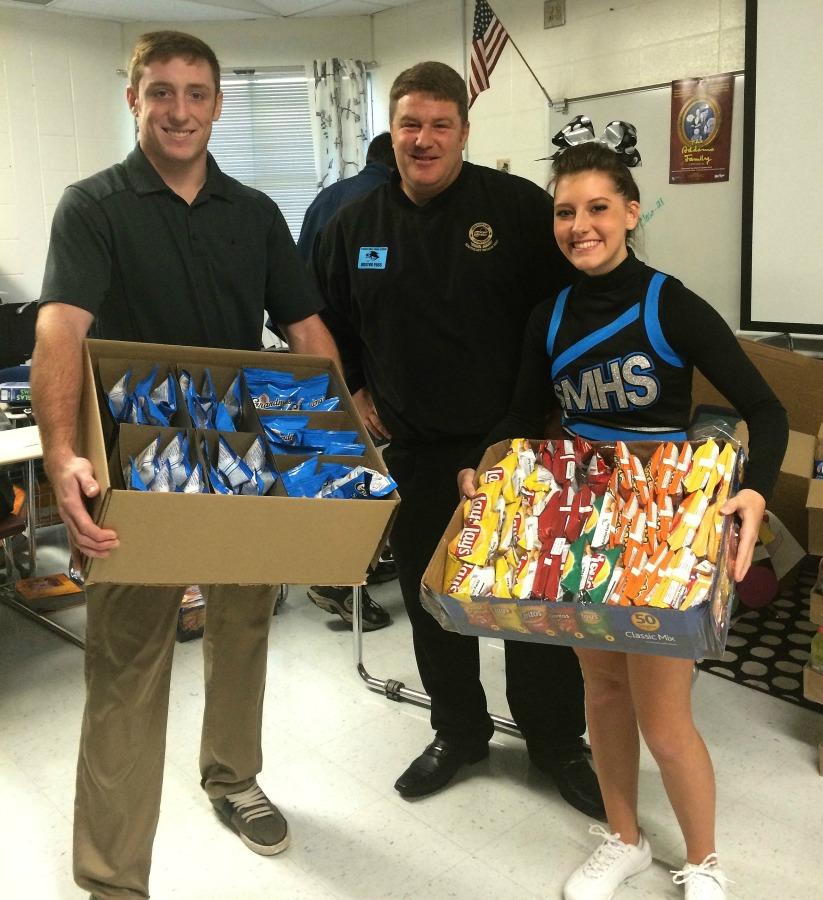English assignment yields tasty results
Photo by Starr’s Mill Yearbook: Alaina Davanzo
Juniors Nathan Cockes and Olivia East receive a surprise treat from Frito-Lay representative Dan Shanko after his visit to their classroom.
December 19, 2014
How often do you open a bag of chips and find it primarily full of air?
This is often the case for snack-eaters around the globe. When juniors Nathan Cockes and Olivia East were given an assignment by Whitney Shoemaker, their second period American Literature teacher, to write a letter of complaint, they decided to write their letters to the Frito-Lay snack company, known for their chips, questioning the abundance of air in their snack bags that can sometimes make a bag of chips seem as if it is more “air” than the snack product that they just paid for.
Most students in the class received answers to their letters with the occasional package of merchandise or replacements in an attempt to alleviate the problem addressed. However, Cockes and East received a personal visit from Frito-Lay representative Dan Shanko.
He came to their class on Friday, Nov 2. to explain exactly why there is “extra” air in the bags of potato chips. He gave students an inside look at how the chips are made, too, along with lots of facts and figures about production rates and cycles and other snacks Frito-Lay makes.
”I was just surprised he came out,” East said. “Most people just got letters.” But Shanko said he was happy to visit the students because his company cares about its customers and he wanted o answer their questions.
Frito-Lay is one of six companies in the U.S. owned by the Pepsi Corporation. The other five are Gatorade, Quaker Oats, Tropicana, Naked Juice and Lipton.
Shanko answered the question about the extra air in the bags as soon as he started his presentation. “The ‘air’ in the bags in actually nitrogen to help our products have the longest shelf life on the market,” Shanko said. He said it is part of Frito-lays’ commitment to sell the most enjoyable products possible. The company attempts to be the most sought-after brand of snack foods. Adding nitrogen helps the chips stay fresher longer by slowing the decay process and acting as a cushion for the falls and drops the products may endure during shipping and stocking.
He mentioned other factors in the snack creation process such as product handling during and after production. He additionally spoke about how the shipping process compresses the snack product and makes it seem as if there is less than there truly is. These factors can make a bag of chips seem to contain less product.
“They (the snack products) are bagged by weight, so they all start with the same amount,” said Shanko, showing that the company tries to make the bags full but uncontrollable factors affect the bag and move the product all to the bottom.
Shanko also discussed the changes the company has had to make in their products and advertising because of U.S. peoples decisions to become more health-conscious and avoid their favorite “junk-foods.” A major change Frito-Lay made to combat dropping sales has been introducing types of snacks in reduced fat and baked forms, to keep sales at their regular level. They have also used new advertising campaigns, such as the “Do Us a Flavor” consumer contest.
The Lays “Do us a Flavor” contest is a way to advertise and get consumers involved with the company itself. The campaign allows anyone to visit the Lays website and submit a new flavor idea. The company then votes for the best four, and those are sold for a designated period of time. The contributors of the three best flavors are awarded $50,000. The flavor with the most sales is then officially added to the Lays product line, and the winner gets a $1 million prize.
Shanko ended his presentation by handing Cockes and East boxes of assorted Frito-Lay products. Additionally he passed out other products to the rest of the class, including Grandma’s Cookies and orange and lemon-lime flavored Gatorade.




